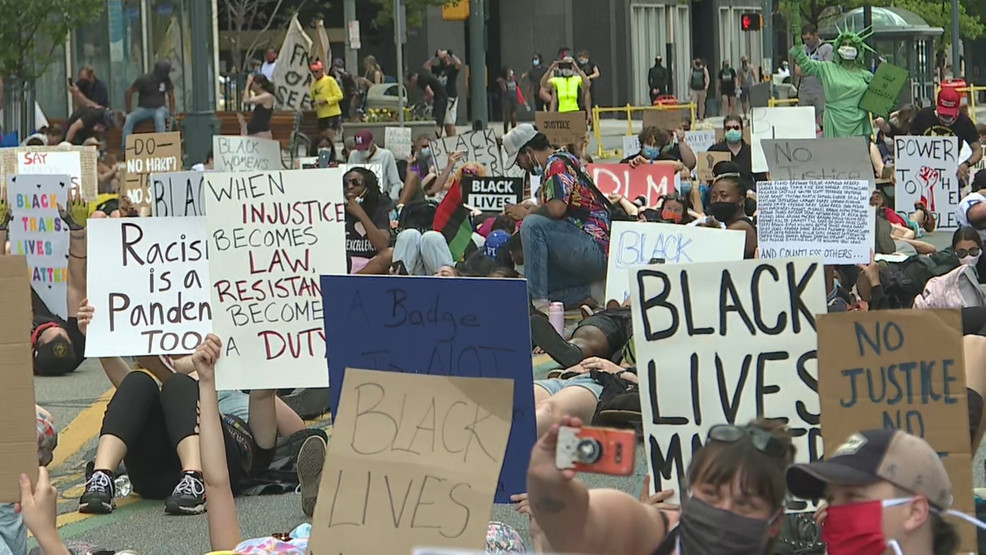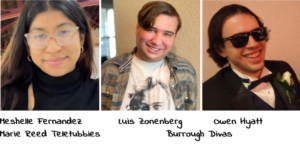The Murder of George Floyd and Its Aftermath

Photo courtesy of 13wham.com
By Jessica Fetrow and Noelia Veras
On May 25, 46-year-old George Floyd was killed in an encounter with four Minneapolis police officers after being suspected of using a counterfeit $20 bill to purchase cigarettes from a deli. Floyd, an African American man, was outside of the deli when police responded to a report made by an employee; Floyd died seventeen minutes later at the hands of Officer Derek Chauvin, who kneeled on his neck for a total of 8 minutes and 46 seconds, as three other police officers stood by. As Chauvin was kneeling on the man’s neck he exclaimed that he could not breathe several times.
Since the tragedy, all four of the police officers have been fired and charged for their involvement in the death of Floyd. Chauvin has been charged with second-degree murder in addition to the initial charge of third-degree murder and one count of involuntary manslaughter. The other three officers who were considered bystanders have been charged with aiding and abetting murder. Although Floyd and Chauvin had both worked as security guards for the same nightclub, there is not any significant evidence towards the premediation of Floyd’s murder.
Initially, the county medical examiner’s office stated that the cause of death was “cardiopulmonary arrest complicating law enforcement subdual, restraint, and neck compression,” with no mention of asphyxia, which insinuated that the man’s death was due to cardiac arrest, not necessarily a direct consequence of the officers’ actions. According to this report, heart disease was an underlying issue that may have contributed to his death, and traces of fentanyl and methamphetamine were listed as “significant conditions,” although there is no mention of how much of these drugs were in his system.
There have been several calls for the arrest of the county medical examiner since a private autopsy later revealed that the cause of death was actually due to mechanical asphyxia, directly implicating police officer Chauvin..
Floyd’s murder caused outrage throughout not only the United States, but internationally, as well. The Black Lives Matter movement has disseminated even further than its initial influence and people everywhere have been united to demand change. Despite the presence of a global pandemic, people are still protesting the injustice of Floyd’s death and racial discrimination. Protests have spurred in all 50 states, as well as in Britain, Germany, France, Denmark, Italy, Syria, Brazil, Mexico, Ireland, New Zealand, Canada, Poland, and Australia.
Social media has been a powerful tool along with protests during this time, as people have been sharing links to petitions and donation websites in order to get justice for the Black lives that have been lost due to systemic racism and police brutality. One of the most popular social media trends to highlight the Black Lives Matter movement was #BlackoutTuesday where people posted black squares with the hashtag and stayed off of social media. This received some backlash as it was labeled as a trend rather than something that was actively encouraging people to contribute to a shift in systemic racism.
YouTube celebrity Zoe Amira recognized that many young people may not have money to donate but they do have their time to help. Amira later published an hour-long YouTube video that has since gone viral and she will be donating the ad revenue from the video to raise money for Black Lives Matter initiatives.
Recent protests have received criticism by some people due to the looting which arose in some areas. People have been hesitant to support protests because of the chaos that some have caused in areas, even though only a small percentage of protestors are actually looting. Monuments and public statues of Confederate soldiers are also being vandalized and destroyed.
President Donald Trump has been criticized for publishing a tweet which denounced looters as thugs, declaring that “when the looting starts the shooting starts.” Many believe Trump’s responses are glorifying violence rather than soothing it.
Additionally, people fear protests because of the potential of police brutality. Many stories of masses of people being tear-gassed and shot with rubber bullets have spread, inciting fear and more anger toward the police force.
President Trump was seen holding a bible in front of St. John’s Episcopal Church in order to encourage hope, but many have similarly criticized him, claiming this as a publicity stunt.
“He used violent means to ask to be escorted across the park into the courtyard of the church,” said Bishop Mariann Edgar Budde of the Episcopal Diocese of Washington, according to NPR.
Trump faced further backlash after attending a pre-planned visit with the first lady to the Saint John Paul II National Shrine on Tuesday in celebration of a recent international religious liberty executive. Several religious figures condemned the presidential visit, such as Archbishop Wilton D. Gregory of the Archdiocese of Washington.
“I find it baffling and reprehensible that any Catholic facility would allow itself to be so egregiously misused and manipulated in a fashion that violates our religious principles, which call us to defend the rights of all people even those with whom we might disagree,” said Gregory in a statement on Tuesday.
A small, peaceful protest assembled outside of the Basilica of the National Shrine of the Immaculate Conception in preparation for the presidential visit. Catholic University’s Department of Public Safety issued an email in response to the protest, informing members of the community that DPS was “aware of demonstrators in the area of Catholuc Universtiy,” and that “the demonstrators are being monitored by DPS, the Metropolitan Police Department, and the Secret Service.” Several prominent members of the Catholic University have issued statements regarding the death of Floyd and the subsequent protests throughout the D.C. area.
“I want to join my voice to those who have expressed sorrow and anger at the death of George Floyd,” said Catholic University president John Garvey in a statement on Monday. “The manner of his death was inexcusable. I offer my condolences and prayers to Floyd’s family and friends, and to the members of our University community who have been affected by his death.”
In his statement, Garvey acknowledged the subject of race and discrimination in the light of the Catholic faith.
“I want to take this occasion to restate a few of the key beliefs of this University community. Our faith condemns racism and discrimination of any kind. They have no place on the campus of The Catholic University of America,” Garvey said. “Our Church teaches that ‘[e]very form of social or cultural discrimination in fundamental personal rights on the grounds of sex, race, color, social conditions, language, or religion must be curbed and eradicated as incompatible with God’s design.’”
University Chaplain and Director of Campus Ministry Rev. Fr. Jude DeAngelo also issued a statement and prayer on Monday to the Catholic University community.
“We cannot let the cries for justice and equality be drowned out once again by the cacophony of calls for destruction and vengeance,” DeAngelo said. “Let not the images of violence and destruction blind us to the vision that we are one nation and one people bound together by our common destiny as children of God.”
In addition to the statements, various offices throughout Catholic University, such as the Counseling Center, have listed resources for students in light of the current racial tension in the country. Students looking to file a report are encouraged to use the Compliance and Ethics Hotline or file a Title IX report through the university.






